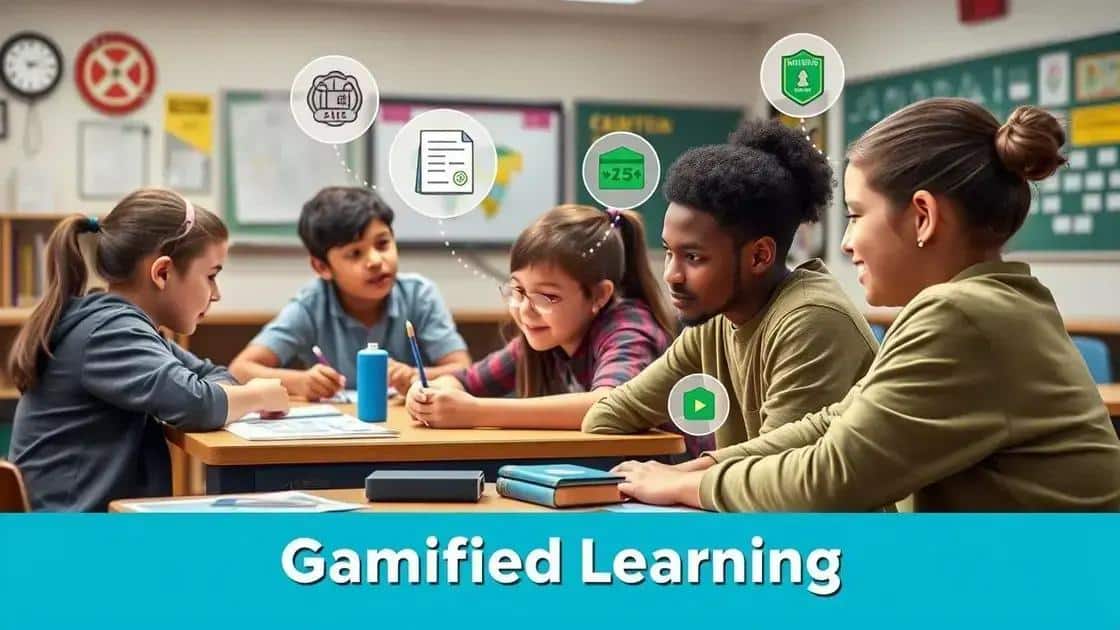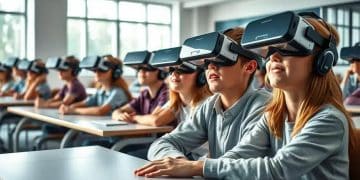Insights on gamified learning platforms for effective training

Insights on gamified learning platforms reveal their potential to enhance engagement, motivation, and knowledge retention by incorporating game mechanics into educational experiences.
Insights on gamified learning platforms reveal their potential to enhance learner engagement and motivation. Have you ever wondered how game elements can transform traditional education? Let’s explore this intriguing concept.
Understanding gamified learning platforms
Understanding gamified learning platforms is essential for leveraging their potential in education and training. These platforms integrate game mechanics into learning experiences, making them more engaging and effective. They promote a sense of achievement, encouraging learners to progress and explore new concepts.
What Are Gamified Learning Platforms?
Gamified learning platforms use elements of game design to enhance the educational process. This includes incorporating rewards, badges, and levels that motivate learners. The goal is to create a more interactive and enjoyable experience.
Key Elements of Gamification
- Points and Rewards: Earned through completing tasks, making learning more motivating.
- Leaderboards: Foster competition by displaying top performers, driving engagement.
- Challenges: Encourage users to solve problems and complete quests for deeper understanding.
- Feedback: Instant responses help learners track progress and adjust their strategies.
By engaging with these elements, learners can better retain information. Additionally, gamified learning promotes collaboration among peers, creating a supportive community that fosters knowledge sharing. This interactive nature allows learners to tackle challenges together and celebrate achievements.
As we dive deeper into the structure of these platforms, it becomes clear that they cater to diverse learning styles. Visual learners benefit from animations and graphics, while auditory learners engage through narratives and sound effects. Kinesthetic learners thrive in environments where they can actively participate and manipulate elements.
Benefits of Using Gamified Learning Platforms
Adopting these platforms can lead to remarkable educational outcomes:
- Increased Engagement: Gamification captures users’ attention, making learning fun.
- Better Knowledge Retention: Interaction leads to stronger memory connections.
- Motivation: Achievements boost confidence, encouraging ongoing participation.
- Flexibility: Learners can progress at their own pace, promoting personalized learning experiences.
This blend of engagement and education offers a powerful avenue for skill development. Through gamification, learners do not just consume content—they actively participate in their own learning journey. This approach transforms mundane tasks into exciting challenges, fostering a passion for learning.
Key benefits of gamified learning

The key benefits of gamified learning platforms are transforming the educational landscape. By incorporating game mechanics, these platforms enhance engagement and motivation, making learning feel more enjoyable and less like a chore. Learners are more likely to immerse themselves in content that rewards them for participation and progress.
Enhanced Motivation
One of the most significant benefits is the increase in learner motivation. Traditional methods can often lead to disengagement, while gamification encourages users to participate actively. Through rewards and challenges, students feel a sense of accomplishment, which drives them to keep learning.
Improved Retention of Knowledge
Gamified learning supports better retention of knowledge by making the learning process interactive. When learners engage with the material in a dynamic and memorable way, they can recall information more effectively. This is particularly true when learners can visualize concepts through games.
- Interactive Learning: Engaging with content makes it easier to understand and remember.
- Frequent Feedback: Instant feedback helps learners adjust their strategies quickly.
- Social Interaction: Collaborating with peers in challenges fosters deeper understanding.
Moreover, these platforms allow for personalization of learning experiences. Each learner can progress at their own pace, adapting goals based on their unique needs. This flexibility encourages learners to take ownership of their educational journey.
Development of Critical Skills
Gamified learning not only entertains but also develops essential skills. Critical thinking and problem-solving are often highlighted in game scenarios. Learners encounter challenges that require them to think creatively and strategically.
- Collaboration: Working together in teams boosts interpersonal skills.
- Time Management: Learners must complete tasks within set timeframes, honing this critical ability.
- Adaptability: Overcoming challenges in games prepares learners for unexpected situations.
As learners navigate through gamified environments, they naturally improve their abilities to manage tasks and interact with others. Overall, the key benefits of gamified learning platforms showcase the power of integrating fun with education, leading to a more motivated and skilled workforce.
Effective strategies for implementation
Implementing gamified learning platforms requires careful planning and execution. Effective strategies help ensure that these platforms meet learning goals and engage users. A well-defined approach can lead to significant improvements in student motivation and retention.
Understanding Your Audience
Knowing your audience is crucial for effective implementation. Different learners have unique preferences and needs. By understanding these differences, educators can tailor gamified elements to resonate with diverse groups, ensuring that the platform is engaging for everyone.
Setting Clear Objectives
Before rolling out a gamified learning platform, it’s essential to establish clear educational objectives. What do you want learners to achieve? Setting specific, measurable targets helps guide the development of the platform. For instance, are you focusing on improving test scores, enhancing participation, or developing critical thinking skills?
- Define Goals: Determine what success looks like for your learning initiative.
- Choose Metrics: Identify how you will measure progress.
- Align with Curriculum: Ensure the platform supports and enhances existing curriculum goals.
Once objectives are in place, the next step is to incorporate game mechanics that foster engagement. This could include rewards systems, badges, or leveling up as learners progress. When learners see tangible rewards for their efforts, they are more likely to stay engaged.
Testing and Feedback
One of the most effective strategies is to conduct testing and gather feedback. Pilot programs can provide valuable insights into what works well and what needs adjustment. Surround learners with opportunities to share their thoughts on the platform, which helps refine the experience.
- Collect Feedback: Use surveys to gather learner input on their experiences.
- Analyze Data: Monitor usage patterns to identify areas for improvement.
- Iterate: Continuously make improvements based on feedback.
This iterative process allows for ongoing enhancement of the platform. Engaging with users ensures the learning experience remains relevant and meaningful.
Training educators on how to utilize these platforms effectively is equally important. Providing workshops or resources equips teachers with the knowledge to facilitate gamified learning successfully. Well-trained instructors can create enriching environments where students feel supported in their learning journey.
Measuring success in gamified learning

Measuring success in gamified learning is vital to understanding its impact on educational outcomes. Without proper measurement, it is challenging to determine whether the objectives set for the program are being met. Clear metrics help educators assess both student engagement and knowledge retention effectively.
Defining Success Metrics
The first step in measuring success is to define what success looks like. Determine the key performance indicators (KPIs) that align with your educational goals. Are you looking to improve test scores, enhance participation, or develop specific skills? Setting precise metrics helps in tracking progress.
Quantitative Metrics
Quantitative metrics provide measurable data to evaluate the success of gamified learning platforms. Some useful metrics include:
- Completion Rates: Track how many learners finish the assigned tasks or courses.
- Engagement Levels: Measure the frequency and duration of interactions with the platform.
- Assessment Scores: Analyze test scores before and after the implementation of gamified learning.
These metrics provide clear insights into how learners are responding to the gamified elements. A steady increase in these numbers can indicate that learners are enjoying the platform and finding value in it. However, it is also essential to complement these quantitative metrics with qualitative insights.
Qualitative Feedback
In addition to numerical data, qualitative feedback plays a crucial role in understanding learners’ experiences. Gathering feedback helps uncover areas for improvement and strengths of the platform. Consider these methods:
- Surveys: Create questionnaires to gather learner opinions on the gamified elements.
- Focus Groups: Engage small groups of learners to discuss their experiences in detail.
- Interviews: Conduct one-on-one interviews to dig deeper into individual experiences.
Qualitative data provides context to the numbers, helping educators identify what resonates with learners. For example, while completion rates may be high, feedback may reveal that learners found specific tasks too challenging or not engaging enough.
Regularly revisiting and analyzing both qualitative and quantitative data is essential for continuous improvement. By adjusting gamified elements based on learner feedback and performance, educators can create a more effective and engaging learning environment. Ultimately, measuring success in gamified learning not only helps in understanding its impact but also guides future decisions.
In conclusion, utilizing gamified learning platforms can significantly enhance the educational experience for both learners and educators. By focusing on effective strategies for implementation and appropriate metrics for measurement, you can create dynamic learning environments that motivate students and improve their outcomes. Remember to engage with learners, gather feedback, and adapt the approach as needed. This ongoing process will allow you to refine your methods and ensure lasting success in the educational journey.
FAQ – Frequently Asked Questions about Gamified Learning Platforms
What are gamified learning platforms?
Gamified learning platforms use game mechanics to enhance the educational experience, making learning more engaging and interactive.
What are the benefits of using gamified learning?
The benefits include increased motivation, improved knowledge retention, enhanced engagement, and the development of critical skills.
How can success be measured in gamified learning?
Success can be measured using both quantitative metrics like completion rates and qualitative feedback from learners.
What strategies can help implement gamified learning effectively?
Effective strategies include understanding your audience, setting clear objectives, and regularly gathering feedback to improve the experience.





